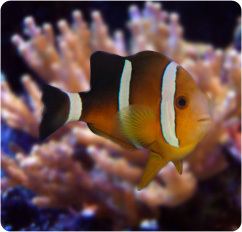Order Perciformes Genus Amphiprion Higher classification Anemonefishes | Phylum Chordata Scientific name Amphiprion tricinctus Rank Species | |
 | ||
Similar Clownfish, Amphiprion chrysogaster, Amphiprion fuscocaudatus, Amphiprion akindynos, Amphiprion omanensis | ||
Amphiprion tricinctus, also known as the three-band anemonefish, is a species of anemonefish that is endemic to the Marshall Islands in the western part of the Pacific Ocean. Like all anemonefishes it forms a symbiotic mutualism with sea anemones and is unaffected by the stinging tentacles of the host anemone. It is a sequential hermaphrodite with a strict sized based dominance hierarchy: the female is largest, the breeding male is second largest, and the male non-breeders get progressively smaller as the hierarchy descends. They exhibit protandry, meaning the breeding male will change to female if the sole breeding female dies, with the largest non-breeder becomes the breeding male. The fish's natural diet includes zooplankton.
Contents
Description
The body of A. tricinctus is yellow-orange at the snout, belly, pelvic and anal fins tending to dark brown or black at the tail. As the common name suggests, as an adult it has 3 white bands or bars. They can grow to be about 13 centimetres (5.1 in) long
Color variations
As A. tricinctus is endemic to the Marshall Islands there are no geographic variation, however there are variations to the proportions of orange and black, from predominately orange through to predominantly black and the occasional aberrant coloration. Fish living with the host anemone Stichodactyla mertensii, Mertens' carpet sea anemone, are frequently black except for the snout and bars.
Similar species
There are 2 other species with 3 body bars and a dark tail, A. chrysogaster and A. fuscocaudatus. however the species are geographically separated. 3 other species of anemonefish are found in the Marshall Islands, A. chrysopterus, A. melanopus and A. perideraion. These are easily distinguished from A. tricinctus as A. chrysopterus has two body bars and a whitish caudal fin, A. melanopus only has a head bar, while A. perideraion as a distinctive white stripe on the dorsal ridge. Genetic analysis has shown that A. tricinctus is closely related to A. clarkii and this clade is significantly different from the other species traditionally considered part of the clarkii complex.
Distribution and habitat
A. tricinctus is endemic to the Marshall Islands in the western part of the Pacific Ocean and is found in lagoons, pinnacle and seaward reefs. Whilst it is most commonly found at depths of 3 to 40 metres (9.8 to 131.2 ft), it is occasionally found hosted by solitary specimens of Entacmaea quadricolor seaward reef slopes in excess of 40 metres (130 ft) deep.
Host anemones
The relationship between anemonefish and their host sea anemones is not random and instead is highly nested in structure. A. tricinctus is highly generalised, being hosted by 8 out of the 9 host anemones found in the Marshall Islands. A. tricinctus is generally said to be associated with the following species of anemone:
There are many locations in the Marshall Islands that have not been scientifically surveyed, and A. tricinctus has been reported to be hosted by the following species of anemone:
Conservation status
Anemonefish and their host anemones are found on coral reefs and face similar environmental issues. Like corals, anemone's contain intracellular endosymbionts, zooxanthellae, and can suffer from bleaching due to triggers such as increased water temperature or acidification. Characteristics known to elevate the risk of extinction are small geographic range, small local population and extreme habitat specialisation. A. tricinctus is an endemic species, confined to the Marshall Islands, and it is thought that this species ability to use a variety of anemone hosts reduces the risk of extinction associated with specialisation.
In the aquarium
Specimens of A. tricinctus are occasionally for sale and the species has been bred in captivity.
